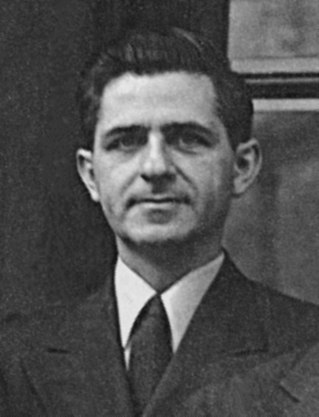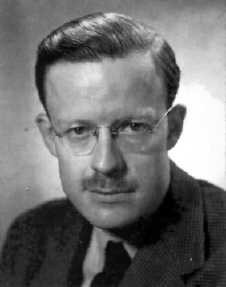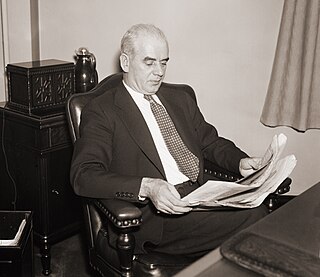Related Research Articles

The American Federation of Labor was a national federation of labor unions in the United States that continues today as the AFL–CIO. It was founded in Columbus, Ohio, in 1886 by an alliance of craft unions eager to provide mutual support and disappointed in the Knights of Labor. Samuel Gompers was elected the full-time president at its founding convention and was re-elected every year except one until his death in 1924. He became the major spokesperson for the union movement.

David Lewis was a Canadian labour lawyer and social democratic politician. He was national secretary of the Co-operative Commonwealth Federation (CCF) from 1936 to 1950 and one of the key architects of the New Democratic Party (NDP) in 1961. In 1962, he was elected as the Member of Parliament (MP), in the House of Commons of Canada, for the York South electoral district. While an MP, he was elected the NDP's national leader and served from 1971 until 1975. After his defeat in the 1974 federal election, he stepped down as leader and retired from politics. He spent his last years as a university professor at Carleton University, and as a travel correspondent for the Toronto Star. In retirement, he was named to the Order of Canada for his political service. After suffering from cancer for a long time, he died in Ottawa in 1981.

Edward Bigelow Jolliffe was a Canadian social democratic politician and lawyer from Ontario. He was the first leader of the Ontario section of the Co-operative Commonwealth Federation (CCF) and leader of the Official Opposition in the Ontario Legislature during the 1940s and 1950s. He was a Rhodes Scholar in the mid-1930s, and came back to Canada to help the CCF, after his studies were complete and being called to the bar in England and Ontario. After politics, he practised labour law in Toronto and would eventually become a labour adjudicator. In retirement, he moved to British Columbia, where he died in 1998.

The Canadian Labour Congress, or CLC is a national trade union centre, the central labour body in Canada to which most Canadian labour unions are affiliated.
Murray Cotterill was a Canadian trade union activist and organizer for the Co-operative Commonwealth Federation (CCF).

The United Steel, Paper and Forestry, Rubber, Manufacturing, Energy, Allied Industrial and Service Workers International Union, commonly known as the United Steelworkers (USW), is a general trade union with members across North America. Headquartered in Pittsburgh, the United Steelworkers represents workers in Canada, the Caribbean, and the United States. The United Steelworkers represent workers in a diverse range of industries, including primary and fabricated metals, paper, chemicals, glass, rubber, heavy-duty conveyor belting, tires, transportation, utilities, container industries, pharmaceuticals, call centers and health care.

Operation Dixie was the name of the post-World War II campaign by the Congress of Industrial Organizations to unionize industry in the Southern United States, particularly the textile industry. Launched in the spring of 1946, the campaign ran in 12 Southern states and was undertaken as part of a dual effort to consolidate wage gains won by the trade union movement in the Northern United States by raising wage levels in the South while simultaneously transforming the conservative politics of the region, thereby allowing the trade union agenda to win on a national scale.
The Trades and Labor Congress of Canada was a Canada-wide central federation of trade unions from 1886 to 1956. It was founded at the initiative of the Toronto Trades and Labour Council and the Knights of Labor. It was the third attempt at a national labour federation to be formed in Canada: it succeeded the Canadian Labour Union which existed from 1873 to 1877 and the Canadian Labour Congress which held only one conference in 1881.

The International Fur and Leather Workers Union (IFLWU), was a labor union that represented workers in the fur and leather trades.

The Workers' Unity League (WUL) was established in January 1930 as a militant industrial union labour central closely related to the Communist Party of Canada on the instructions of the Communist International.
The Steel Workers Organizing Committee (SWOC) was one of two precursor labor organizations to the United Steelworkers. It was formed by the CIO on June 7, 1936. It disbanded in 1942 to become the United Steel Workers of America. The Steel Labor was the official paper of SWOC.
Charles Hibbert (Charlie) Millard was a Canadian trade union activist and politician.
Lynn Russell Williams was a Canadian labour leader best remembered as the International President of the United Steelworkers union (USW) from 1983 until his retirement in 1994. Williams was the first Canadian to head a major North American industrial union.
Robert Hugh Carlin was a Canadian labour union organizer and politician, who represented the electoral district of Sudbury in the Legislative Assembly of Ontario from 1943 to 1948. He was a member of the Co-operative Commonwealth Federation (CCF).

The One Big Union (OBU) was a Canadian syndicalist trade union active primarily in the western part of the country. It was initiated formally in Calgary on June 4, 1919, but lost most of its members by 1922. It finally merged into the Canadian Labour Congress in 1956.
This is a timeline of labour issues and events in Canada.

The Congress of Industrial Organizations (CIO) was a federation of unions that organized workers in industrial unions in the United States and Canada from 1935 to 1955. Originally created in 1935 as a committee within the American Federation of Labor (AFL) by John L. Lewis, a leader of the United Mine Workers (UMW), and called the Committee for Industrial Organization. Its name was changed in 1938 when it broke away from the AFL. It focused on organizing unskilled workers, who had been ignored by most of the AFL unions.
The following is a timeline of the history of labour organizations in communities in and around Greater Sudbury, Ontario, Canada. Listings for incorporated townships which were later amalgamated with the City of Sudbury are noted separately.
The United Rubber, Cork, Linoleum and Plastic Workers of America (URW) was a labor union representing workers involved in manufacturing using specific materials, in the United States and Canada.
References
- Caplan, Gerarld (1973). The Dilemma of Canadian Socialism: The CCF in Ontario . Toronto: McClelland and Stewart.
- Horowitz, Gad (1968). Canadian Labour in Politics . University of Toronto Press.